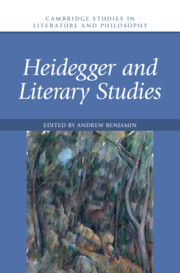258 results
The Causes and Consequences of Refugee Flows: A Contemporary Reanalysis
-
- Journal:
- American Political Science Review , First View
- Published online by Cambridge University Press:
- 07 May 2024, pp. 1-9
-
- Article
-
- You have access
- Open access
- HTML
- Export citation
Workshop for the protection of Chinese giant salamanders
-
- Article
-
- You have access
- Open access
- HTML
- Export citation
Investigating Crimean–Congo haemorrhagic fever virus seropositivity in camels and human behavioural risks in an abattoir in Nigeria
-
- Journal:
- Epidemiology & Infection / Volume 152 / 2024
- Published online by Cambridge University Press:
- 01 February 2024, e29
-
- Article
-
- You have access
- Open access
- HTML
- Export citation
Impact of primary care triage using the Head and Neck Cancer Risk Calculator version 2 on tertiary head and neck services in the post-coronavirus disease 2019 period
-
- Journal:
- The Journal of Laryngology & Otology , First View
- Published online by Cambridge University Press:
- 22 January 2024, pp. 1-6
-
- Article
- Export citation
Ingestion of a variety of non-animal-derived dietary protein sources results in diverse postprandial plasma amino acid responses which differ between young and older adults
-
- Journal:
- British Journal of Nutrition / Volume 131 / Issue 9 / 14 May 2024
- Published online by Cambridge University Press:
- 15 January 2024, pp. 1540-1553
- Print publication:
- 14 May 2024
-
- Article
-
- You have access
- Open access
- HTML
- Export citation
II - Heidegger and Greek Literature
-
- Book:
- Heidegger and Literary Studies
- Published online:
- 09 November 2023
- Print publication:
- 23 November 2023, pp 119-182
-
- Chapter
- Export citation
Heidegger and Literature: An Introduction to the Question
-
-
- Book:
- Heidegger and Literary Studies
- Published online:
- 09 November 2023
- Print publication:
- 23 November 2023, pp 1-12
-
- Chapter
- Export citation
General Index
-
- Book:
- Heidegger and Literary Studies
- Published online:
- 09 November 2023
- Print publication:
- 23 November 2023, pp 364-376
-
- Chapter
- Export citation
Heidegger, Index of Works
-
- Book:
- Heidegger and Literary Studies
- Published online:
- 09 November 2023
- Print publication:
- 23 November 2023, pp 359-363
-
- Chapter
- Export citation
Contributors
-
- Book:
- Heidegger and Literary Studies
- Published online:
- 09 November 2023
- Print publication:
- 23 November 2023, pp vii-viii
-
- Chapter
- Export citation
III - Heidegger and Literary Works
-
- Book:
- Heidegger and Literary Studies
- Published online:
- 09 November 2023
- Print publication:
- 23 November 2023, pp 183-358
-
- Chapter
- Export citation
I - Literature and Poetry
-
- Book:
- Heidegger and Literary Studies
- Published online:
- 09 November 2023
- Print publication:
- 23 November 2023, pp 13-118
-
- Chapter
- Export citation
Copyright page
-
- Book:
- Heidegger and Literary Studies
- Published online:
- 09 November 2023
- Print publication:
- 23 November 2023, pp iv-iv
-
- Chapter
- Export citation
Contents
-
- Book:
- Heidegger and Literary Studies
- Published online:
- 09 November 2023
- Print publication:
- 23 November 2023, pp v-vi
-
- Chapter
- Export citation

Heidegger and Literary Studies
-
- Published online:
- 09 November 2023
- Print publication:
- 23 November 2023
AntibiogramDSM: a combined local antibiogram and educational intervention
-
- Journal:
- Antimicrobial Stewardship & Healthcare Epidemiology / Volume 3 / Issue 1 / 2023
- Published online by Cambridge University Press:
- 23 October 2023, e179
-
- Article
-
- You have access
- Open access
- HTML
- Export citation
Strategies for Strengthening the Resilience of Public Health Systems for Pandemics, Disasters, and Other Emergencies
-
- Journal:
- Disaster Medicine and Public Health Preparedness / Volume 17 / 2023
- Published online by Cambridge University Press:
- 05 September 2023, e479
-
- Article
-
- You have access
- Open access
- HTML
- Export citation
Decentralized clinical trials in the trial innovation network: Value, strategies, and lessons learned
-
- Journal:
- Journal of Clinical and Translational Science / Volume 7 / Issue 1 / 2023
- Published online by Cambridge University Press:
- 25 July 2023, e170
-
- Article
-
- You have access
- Open access
- HTML
- Export citation
Simulated herbicide spray retention of commonly managed invasive emergent aquatic macrophytes
-
- Journal:
- Weed Technology / Volume 37 / Issue 3 / June 2023
- Published online by Cambridge University Press:
- 22 May 2023, pp. 243-250
-
- Article
-
- You have access
- Open access
- HTML
- Export citation
453 Rapid SARS-CoV-2 testing with duplexed recombinase polymerase amplification and a bacteriophage internal control
- Part of
-
- Journal:
- Journal of Clinical and Translational Science / Volume 7 / Issue s1 / April 2023
- Published online by Cambridge University Press:
- 24 April 2023, p. 134
-
- Article
-
- You have access
- Open access
- Export citation



